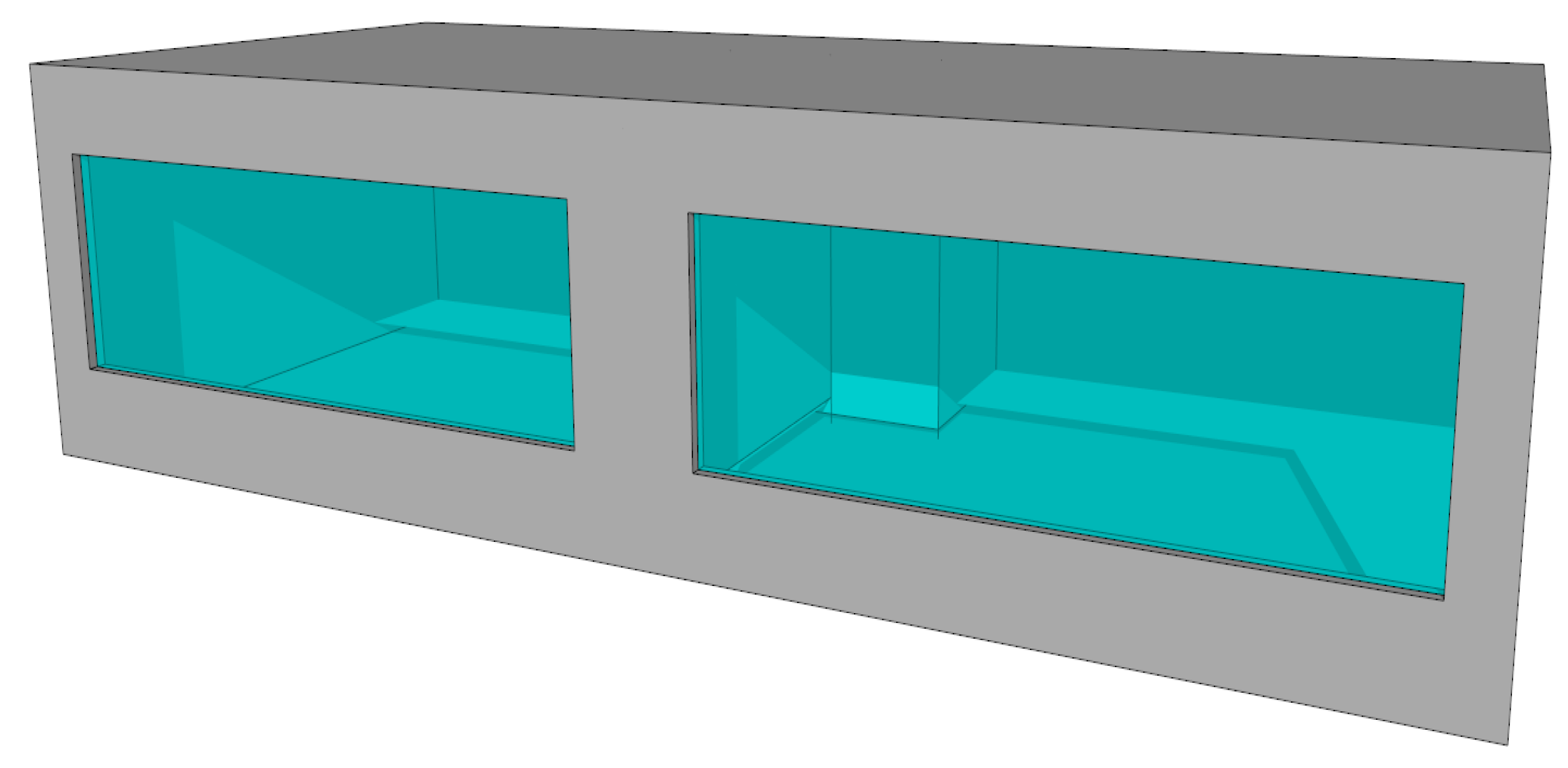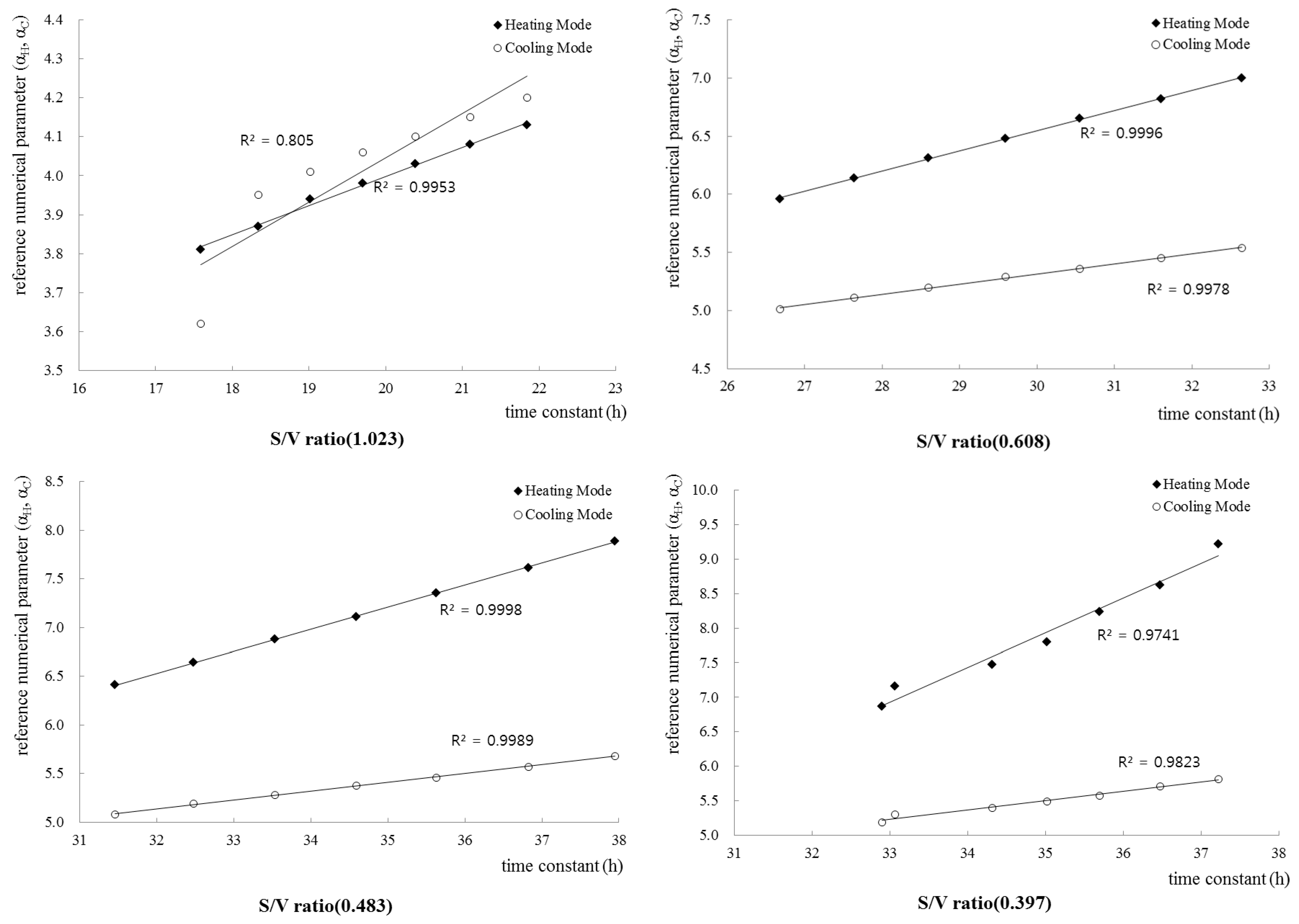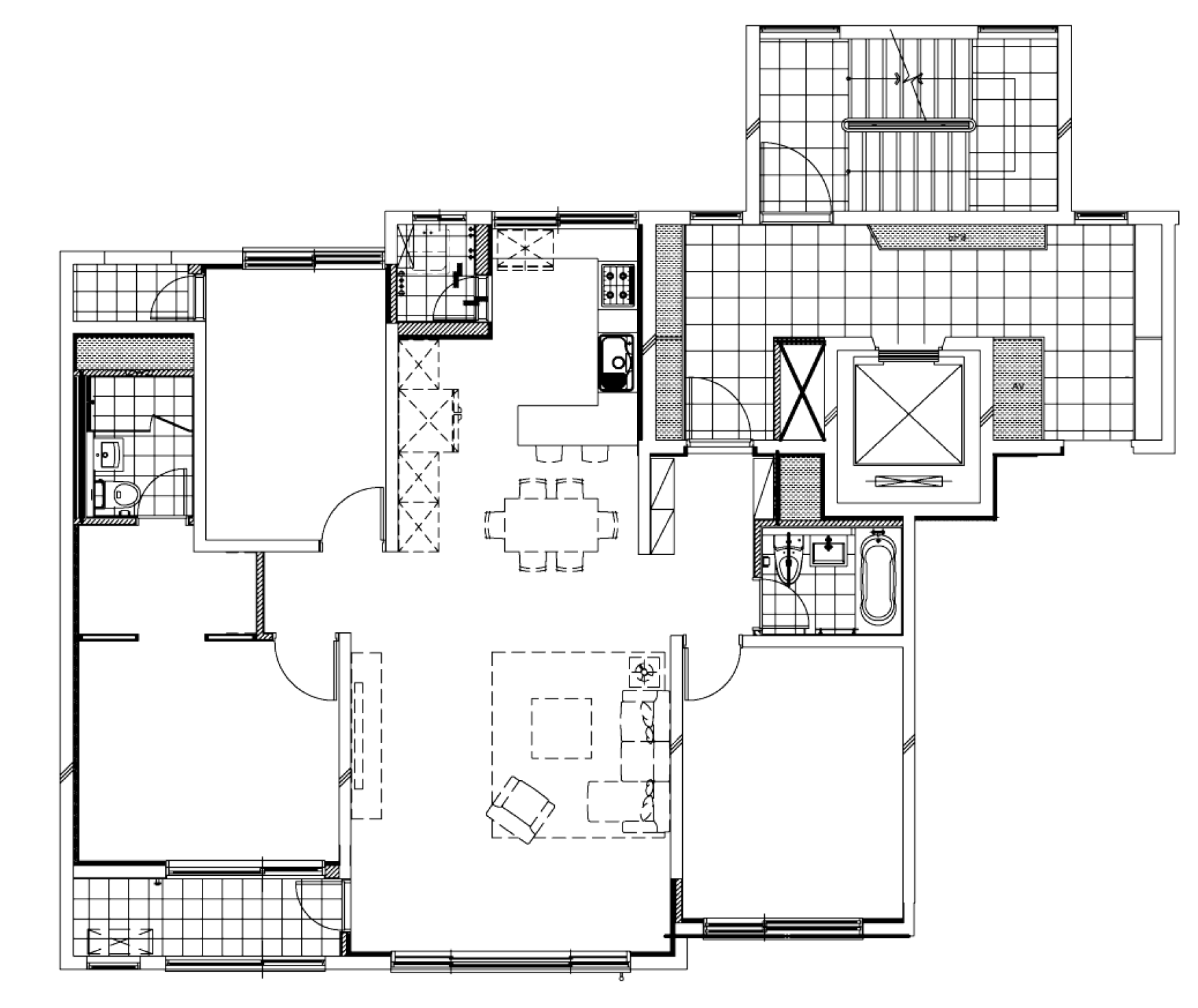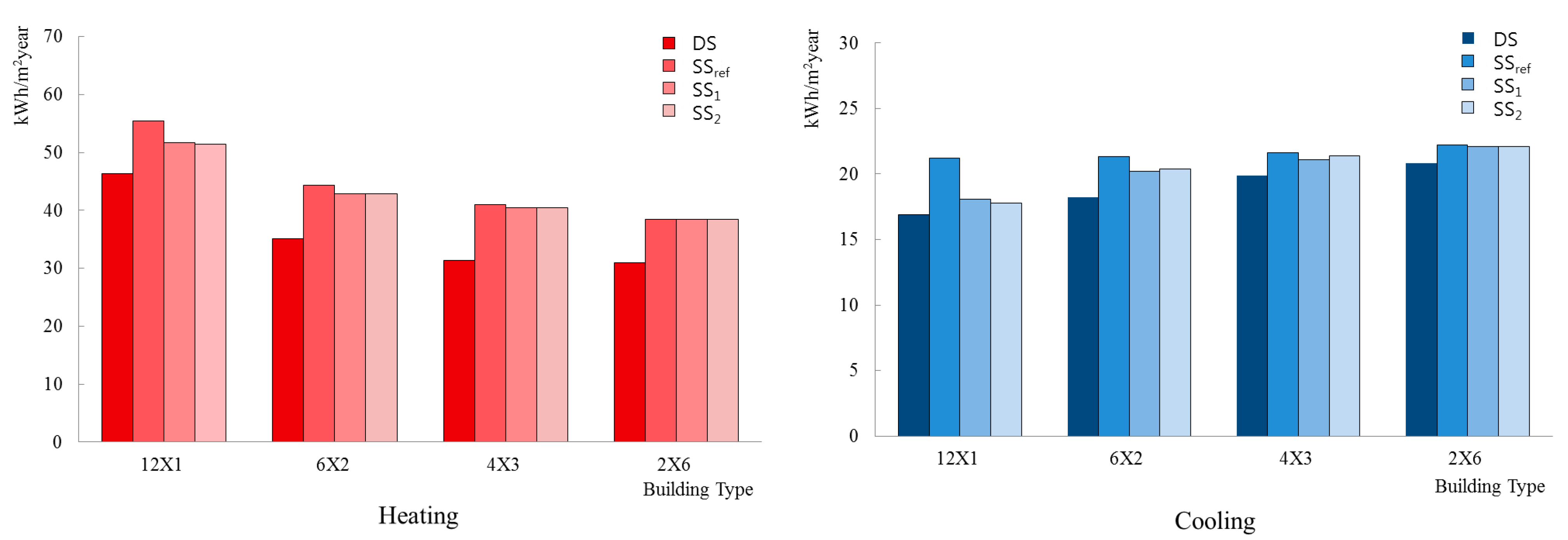Evaluation of the Reference Numerical Parameters of the Monthly Method in ISO 13790 Considering S/V Ratio
Abstract
:1. Introduction
2. Review of Previous Studies on the Reference Numerical Parameters in ISO 13790
2.1. Processes of Calculating Gain and Loss Utilization Factor
| Type of Method | αH,0, αC,0 | τH,0, τC,0 |
|---|---|---|
| Monthly method | 1 | 15 |
2.2. Review of Previous Studies on Deriving the Reference Numerical Parameters
| Country | Reference Numerical Parameter | Regression Equation | Notes |
|---|---|---|---|
| Finland | αH(C),0 = 2, τH(C),0 = 10 | αH(C) = 2 + τ/10 | Light-weight, medium-weight and heavy-weight apartments |
| Italy | αC,0 = 6.3, τC,0 = 17 αC,0 = 8.1, τC,0 = 17 | αC = 6.3 + τ/17 αC = 8.1 + τ/17 − 13ξ | Window-to-wall ratio |
| Poland | Light-weight: αH(C),0 = 2, τH(C),0 = 54 Heavy-weight: αH(C),0 = 2, τH(C),0 = 50 | Light-weight: αH(C) = 2 + τ/54 Heavy-weight: αH(C) = 2 + τ/50 | Light-weight and heavy-weight apartments |
| Denmark | αH,0 = 2.87, τH,0 = 47 αC,0 = 2.79, τC,0 = 35 | αH = 2.87 + τ/47 αC = 2.11 + τ/35 − 2.69ξ | Light-weight, medium-weight and heavy-weight office buildings |
3. Establishment of Input Variables to Calculate the Reference Numerical Parameters
3.1. Model Building
| Location | Republic of Korea (Seoul) |
|---|---|
| Direction | South |
| Building use | Apartment building |
| Unit floor area (m2) | 84 |
| Core floor area (m2) | 16 |
| Height (m) | 2.3 |
| Area on Surface | Thermal Transmittance (W/m2K) | |
|---|---|---|
| Roof | 0.18 | |
| External walls | Near to outdoor air | 0.27 |
| Near to semi-outdoor air | 0.37 | |
| Internal wall | - | |
| Floor | 0.81 | |
| Lowest floor | 0.35 | |
| Window | 1.5 | |
| Material | Density (kg/m3) | Specific Heat (J/kgK) | Thermal Conductivity (W/m) | Thermal Resistance (m2K/W) |
|---|---|---|---|---|
| Unreinforced concrete | 2200 | 879 | 0.06 | - |
| Concrete | 2240 | 879 | 1.6 | - |
| Autoclave light-weight concrete | 650 | 1173 | 0.13 | - |
| Gypsum board | 940 | 1130 | 0.18 | - |
| Cement mortar | 1950 | 921 | 1.4 | - |
| Extruded polystyrene form insulation | 35 | 1400 | 0.027 | - |
| Air layer | - | - | - | 0.086 |

3.2. Establishment of Input Data in the Analysis Program
| Input Data | |
|---|---|
| Heating set-point temperature | 20 °C |
| Cooling set-point temperature | 26 °C |
| Number of occupants | 4 persons |
| Internal heat gain: person | 115 W/m2 |
| Internal heat gain: equipment | 7 W/m2 |
| Internal heat gain: lighting | 5.4 W/m2 |
| Natural infiltration rate | 0.3 Air Change per Hour |
| Ventilation rate | 0.7 Air Change per Hour |
4. Derivation of Gain and Loss Utilization Factors and Validity Evaluation

4.1. Simulation Case
| Case | Density of Internal Wall (kg/m2) | Specific Heat of Internal Wall (J/kgK) | Heat Value of S/V Ratio (Wh/K Pro m2 Treated Floor Area) | |||
|---|---|---|---|---|---|---|
| 1.023 | 0.608 | 0.483 | 0.397 | |||
| Case 1 | 1280 | 840 | 46 | 85 | 121 | 215 |
| Case 2 | 1440 | 850 | 48 | 88 | 125 | 219 |
| Case 3 | 1600 | 860 | 49 | 91 | 129 | 223 |
| Case 4 | 1760 | 870 | 51 | 94 | 133 | 227 |
| Case 5 | 1920 | 880 | 53 | 97 | 136 | 232 |
| Case 6 | 2080 | 890 | 55 | 100 | 141 | 236 |
| Case 7 | 2240 | 900 | 56 | 103 | 145 | 241 |
4.2. Calculation of Variables Related to the Reference Numerical Parameters
| Season | Input Condition | Output Data | ||||
|---|---|---|---|---|---|---|
| HVAC Type | Set-Temperature | Solar Radiation | Space Load | Ventilation | ||
| Heating | Single H/C | 20 °C | × | × | ○ | |
| Single H/C | ○ | ○ | ○ | |||
| Dual H/C | ○ | ○ | ○ | |||
| Cooling | Single H/C | 26 °C | × | × | ○ | |
| Single H/C | ○ | ○ | ○ | |||
| Dual H/C | ○ | ○ | ○ | |||
| Heating Season | Cooling Season | |
|---|---|---|
| Heat loss | ||
| Heat gain | ||
| Energy need | ||
| Utilization factor | ||
| Heat-balance ratio |
4.3. Calculation of the Reference Numerical Parameters and the Time Constant

4.4. Derivation of the Reference Numerical Parameters through Regression Analysis
| Season | S/V Ratio (β) | α0 | τ0 | β Coefficient | R2 | Regression Equation |
|---|---|---|---|---|---|---|
| Heating | β = 0 | 0.62 | 4.25 | - | 0.969 | αH = 0.62 + τ/4.25 |
| β ≠ 0 | 14.77 | 10.03 | −8.66 | 0.999 | αH = 14.747 + τ/10.03 − 8.66 β | |
| Cooling | β = 0 | 2.23 | 10.57 | - | 0.940 | αC = 2.23 + τ/10.57 |
| β ≠ 0 | 7.95 | 33.42 | −3.22 | 0.966 | αC = 7.95 + τ/33.42 − 3.22 β |
5. Validity Evaluation of the Reference Numerical Parameters
5.1. Key Features of the Target Apartment Buildings for Evaluation

5.2. Calculation of Parameters during Heating and Cooling Seasons through the Regression Equation
| Type | Heat Capacity (Wh/K Pro m2 TFA) | S/V Ratio | τ (h) | αH | αC |
|---|---|---|---|---|---|
| 12X1 | 45 | 0.922 | 31.3 | 9.91 | 5.92 |
| 6X2 | 84 | 0.494 | 67.1 | 17.18 | 8.37 |
| 4X3 | 120 | 0.356 | 101.3 | 21.79 | 9.83 |
| 2X6 | 216 | 0.233 | 192.1 | 31.90 | 12.95 |
5.3. Analysis of Energy Demand and Error Rates Using the Analysis Program
| Season | Type | Error Rate (%) | ||
|---|---|---|---|---|
| DS and SSref | DS and SS1 | DS and SS2 | ||
| Heating | 12X1 | 19.0 | 11.0 (7.9↓) | 10.5 (8.5↓) |
| 6X2 | 26.4 | 22.5 (3.9↓) | 22.4 (4.0↓) | |
| 4X3 | 30.8 | 28.8 (2.0↓) | 28.8 (1.9↓) | |
| 2X6 | 24.8 | 24.5 (0.3↓) | 24.5 (0.3↓) | |
| Cooling | 12X1 | 25.2 | 7.0 (18.2↓) | 5.3 (19.9↓) |
| 6X2 | 16.7 | 11.0 (5.7↓) | 12.0 (4.7↓) | |
| 4X3 | 8.7 | 6.0 (2.6↓) | 7.6 (1.1↓) | |
| 2X6 | 7.1 | 6.3 (0.7↓) | 6.3 (0.7↓) | |

6. Conclusions
Acknowledgments
Author Contributions
Nomenclature
| Aj | area of the element j (m2) |
| Cm | internal heat capacity of the building or building zone (J/K) |
| ci | heat capacity of a layer i (J/kgK) |
| di | thickness of a layer i (m) |
| kj | areal heat capacity of the building element j (J/m2K) |
Greek Letters
| αC | numerical parameter for the cooling mode, dimensionless |
| αC,0 | reference numerical parameter for the cooling mode, dimensionless |
| αH | numerical parameter for the heating mode, dimensionless |
| αH,0 | reference numerical parameter for the heating mode, dimensionless |
| γH | heat-balance ratio for the heating mode, dimensionless |
| γC | heat-balance ratio for the cooling mode, dimensionless |
| τ | time constant of the building zone (h) |
| τC,0 | reference time constant for the cooling mode (h) |
| τH,0 | reference time constant for the heating mode (h) |
| ρi | density of a layer i (kg/m3) |
Conflicts of Interest
References
- ISO. ISO 13790:2008 Energy Performance of Buildings—Calculation of Energy Use for Space Heating and Cooling; ISO: Geneva, Switzerland, 2008. [Google Scholar]
- Standard Assessment Procedure (SAP). Available online: https://www.gov.uk/standard-assessment-procedure (accessed on 2 December 2014).
- National Building Code. Available online: http://www.ym.fi/en-us (accessed on 2 December 2014).
- Κανονισμοσ Ενεργειακησ Αποδοσησ Κτιριων (KENAK). Available online: http://www.kenak.gr (accessed on 2 December 2014). (In Greek)
- Norsk Standard. In NS 3031:2014. Calculation of Energy Performance of Buildings-Method and Data; Standard Norway: Oslo, Norway, 2014.
- Passive House Planning Package (PHPP). Available online: http://passiv.de (accessed on 2 December 2014).
- ECO2. Available online: http://www.kemco.or.kr (accessed on 2 December 2014).
- Construction Energy-Efficiency-Evaluation (CE3). Available online: http://www.eco-ce3.kr (accessed on 2 December 2014).
- Building Energy Simulation for Seoul (BESS). Available online: http://citybuild.seoul.go.kr (accessed on 2 December 2014).
- Jokisalo, J.; Kurnitski, J. Performance of EN ISO 13790 utilisation factor heat demand calculation method in a cold climate. Energy Build. 2007, 39, 236–247. [Google Scholar] [CrossRef]
- Panek, A.; Rucińska, J.; Mijakowski, M. Adjustment of parameters used for calculation method applied in certification process in Poland. In Proceedings of the CESB10-Central Europe towards Sustainable Building, Prague, Czech, 30 June–2 July 2010.
- Le Dreau, J.; Selman, A.D.; Heiselberg, P.; Jensen, R.L. Thermal Mass & Dynamic Effects Danish Building Regulation; DCE Technical Reports, No. 152; Aalborg University: Aalborg, Denmark, 2013. [Google Scholar]
- Corrado, V.; Fabrizio, E. Assessment of building cooling energy need through a quasi-steady state model: Simplified correlation for gain-loss mismatch. Energy Build. 2007, 39, 569–579. [Google Scholar] [CrossRef]
- Wauman, B.; Breesch, H.; Saelens, D. Evaluation of the accuracy of the implementation of dynamic effects in the quasi steady-state calculation method for school buildings. Energy Build. 2013, 65, 173–184. [Google Scholar] [CrossRef]
- Orosa, J.A.; Oliveira, A.C. Implementation of a method in EN ISO 13790 for calculating the utilisation factor taking into account different permeability levels of internal coverings. Energy Build. 2010, 42, 598–604. [Google Scholar] [CrossRef]
- ISO. ISO 13786:2011 Thermal Performance of Building Components—Dynamic Thermal Characteristics—Calculation Methods; ISO: Geneva, Switzerland, 2011. [Google Scholar]
- Evangelisti, L.; Battista, G.; Guattari, C.; Basilicata, C.; de Lieto Vollaro, R. Influence of the Thermal Inertia in the European Simplified Procedures for the Assessment of Buildings’ Energy Performance. Sustainability 2014, 6, 4514–4524. [Google Scholar]
- Ministry of Land. Building Design Code for Energy Saving; Ministry of Land: Sejong City, Korea, 2012. [Google Scholar]
- American Society of Heating, Refrigerating and Air Conditioning Engineers (ASHRAE). ASHRAE Handbook Fundamentals; ASHRAE: Atlanta, GA, USA, 2009. [Google Scholar]
- Yoon, Y.S.; Yoon, J.H.; Hyun, J.H.; Hwang, W.J.; Shin, J.G.; Choi, W.K.; Mun, S.H. A Study on the Optimal Glazing Units in Apartment—Focused on the Glazing Performance and Heating/Cooling Setpoint Temperature. J. Archit. Instit. Korea 2012, 28, 301–308. [Google Scholar]
- Kim, S.K. A Study on an Energy-Efficient Outdoor Air Supply Control Method in Apartment Ventilation System. Ph.D. Thesis, Dong-A University, Busan, Korea, 2009. [Google Scholar]
- Ministry of Land. Green Home Design and Performance Evaluation Guideline; Ministry of Land: Sejong City, Korea, 2009. [Google Scholar]
© 2015 by the authors; licensee MDPI, Basel, Switzerland. This article is an open access article distributed under the terms and conditions of the Creative Commons Attribution license (http://creativecommons.org/licenses/by/4.0/).
Share and Cite
Kwak, H.-J.; Jo, J.-H.; Suh, S.-J. Evaluation of the Reference Numerical Parameters of the Monthly Method in ISO 13790 Considering S/V Ratio. Sustainability 2015, 7, 767-781. https://doi.org/10.3390/su7010767
Kwak H-J, Jo J-H, Suh S-J. Evaluation of the Reference Numerical Parameters of the Monthly Method in ISO 13790 Considering S/V Ratio. Sustainability. 2015; 7(1):767-781. https://doi.org/10.3390/su7010767
Chicago/Turabian StyleKwak, Hee-Jeong, Jae-Hun Jo, and Seung-Jik Suh. 2015. "Evaluation of the Reference Numerical Parameters of the Monthly Method in ISO 13790 Considering S/V Ratio" Sustainability 7, no. 1: 767-781. https://doi.org/10.3390/su7010767





